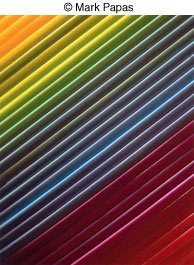So you finally acquired your dream camera, a digital SLR, you fired up your computer, and you are now gazing lovingly at the scene you captured earlier. But wait! What are those black specks cluttering up your beautiful blue sky? Maybe they're little birds or distant airplanes you didn't notice when you took the picture. But when you view the photo at 100% in your image editor, they look like gray smudges or blobs. Think you had dirt on your lens? No my friend, the dirt is on your camera's sensor and happens most often when you change lenses.
Actually, the dirt or dust is on a piece of glass in front of the sensor called the low-pass filter but we commonly refer to that nasty stuff as sensor dust. You can remove the dust from the image by employing various software tools (in Photoshop that means the Clone Stamp, Healing Brush, etc.) but software won't remove it from the sensor. And that little task comprises the rest of this article.
However, before proceeding, I must inject a disclaimer here. Neither I nor the New York Institute of Photography is advising anyone to clean their sensors themselves. You undertake this at your own risk. Done incorrectly or with the wrong tools and you might seriously damage your camera. But if you want to tackle this chore, here's an overview of the various products and strategies other photographers have used.
What about simply blowing the dust off? Fine but not with your breath! You don't want to complicate the job by adding saliva to the sensor. Nor do you want to use canned air because there's a good chance some of the propellant will land on the sensor. Giotto makes a excellent hand blower called the Rocket and the largest size produces a pretty strong stream of air. I have used it a few times on my DSLR's and it might possibly be the only tool you'll ever need. The only problem with blowers is you may simply move the dust around the camera's interior rather than remove it. However, many photographers swear by them.
But what if the dust is still on the sensor? Well, you have two choices at this point. One, send the camera off to a service center and wait, sometimes several weeks, for it to come back. You'll pay for the cleaning and occasionally you might find that the camera still has dust, only it has moved around somewhat. Two, get in there and clean it yourself by actually touching the sensor with one or more of the tools available for this purpose.
Basically, there are two types of cleaning tools – dry and wet. Dry ones include various brushes, swabs, and a few where you simply touch the place on the sensor where the dust is located. Here are some of the more common ones.
Visible Dust Arctic Butterfly: This is a battery-powered brush that you spin to sort of electro statically charge the bristles. The charge should attract any dust particles that are on the sensor. Spinning the brush also will expel any dust on the brush but you don't do this while the brush is touching the sensor, only before and after. The Arctic Butterfly, in its various incarnations, is one of the more popular tools out there.
Kinetronics SpeckGRABBER, LensPen SensorKlear, the Pentax Sensor Cleaning Kit and Visible Dust Bright Vue Sensor Loupe: While each of these products employ different materials; they are similar in how they are used. You basically touch the spot where an individual piece of dust is located and remove it. Of course, you have to be able to see exactly where the dust is and that brings us to magnifiers. Visible Dust makes a unique model called the Bright Vue Sensor Loupe that employs six LED's. The multi-directional illumination makes the dust relatively easy to see.
The only problem with any of the dry tools (and there are many others) relates to the nature of the junk on your sensor. Pollen grains tend to be moist and can be rather tenacious in sticking to the sensor. That goes for any contaminant that contains moisture. In this situation, you may have to go the wet cleaning route in order to remove the crud.
Eclipse Liquid Cleaner: Eclipse is a methanol compound that dries very quickly. Obviously you don't just pour it on the sensor (I hope that's obvious). Eclipse and other liquids are usually used with some sort of swab and you apply a SMALL amount of the liquid to the swab and then wipe the sensor. Eclipse E2 is a slightly different formulation intended for cameras that feature tin oxide sensors, such as the Sony Alphas, the Pentax K10D, and others.
Many of these products are rather expensive so you might be tempted to look for cheap alternatives. I'll just mention a few.
Isopropyl Alcohol: Well, the 90% formulation would dry quickly and have a low water content. Used in conjunction with the aforementioned swabs, it should work.
Windex: This common household glass cleaner is tempting. The low-pass filter is made of glass so…. But I'm a bit leery.
Q-Tips: I don't think so. Even the medical-grade type might leave fibers behind.
Scotch Tape: Don't even think about this one. It might remove the dust particles from the sensor but it will almost certainly leave some nasty adhesive behind.
Many people will be reluctant to touch their DSLR's sensor with anything and I don't blame them. It's a scary process. Anyone who doesn't have a steady hand and good eyesight probably shouldn't attempt it. But getting back to the title of this article – how big a problem IS sensor dust? Unless you routinely shoot at small aperture settings (like f/16 or f/22), you may never see it even if it's there. Likewise, photos that lack broad expanses of single tones, like blue sky. But there are things you can do to limit the opportunity for dust to get in there. One, turn off your camera before you change lenses. The electrical charge on the sensor that exists when the camera is on can attract dust. Try to avoid changing lenses in windy, dusty environments. Some photographers simply insert both the camera and lenses in a plastic bag before doing the changing. Alternatively, you might simply hold the body with the lens mount pointing down. A couple of my colleagues suggest this approach.
What is my personal strategy? Glad you asked. Currently, I use two camera bodies (looking to get a third body), each with a different prime lens that is sort of permanently attached. In short, I don't change lenses at all. I favor prime lenses over zooms (that's a subject for another time) so changing focal lengths is simply a matter of changing bodies. For location shooting, I typically have one body around my neck and the other over my shoulder. It may sound cumbersome but I'm used to it, having employed this approach for many years, long before DSLR's existed. My motive really has little to do with the sensor dust issue.
I realize that owning several camera bodies may not be economical for many students. For that reason, buying a DSLR with a single wide-range zoom lens may be the best option, at least in the beginning. Eventually, however, you will want to use more than one lens. After all, lens interchangeability is one of the features you buy an SLR (digital or film) to have.
So suppose you do wind up with a couple of little dust spots visible in your image. No need to panic. You can always spot them out in your image editor, as I mentioned earlier. Not much fun if the photo is of someone's face but since we usually use wide aperture settings for such shots, any dust probably won't be visible.
My final word on this subject is simply this – don't get stressed out over sensor dust. It's not as big a deal as some people make out, especially those with some product to sell. Anyway, a few current DSLR models feature some sort of cleaning technology built into the camera. How effective they are is a big question but clearly this is the direction that DSLR development is going. Only time will tell whether sensor dust will become a thing of the past.
As a wedding photographer, NYIP Student Advisor Rachel Neville has a different perspective on sensor cleaning, so don't miss her article "Sensor Dust ‚ A Different Opinion for Portrait and Wedding Photographers"
Learn more about camera care and all things photography with one of our photography classes.






